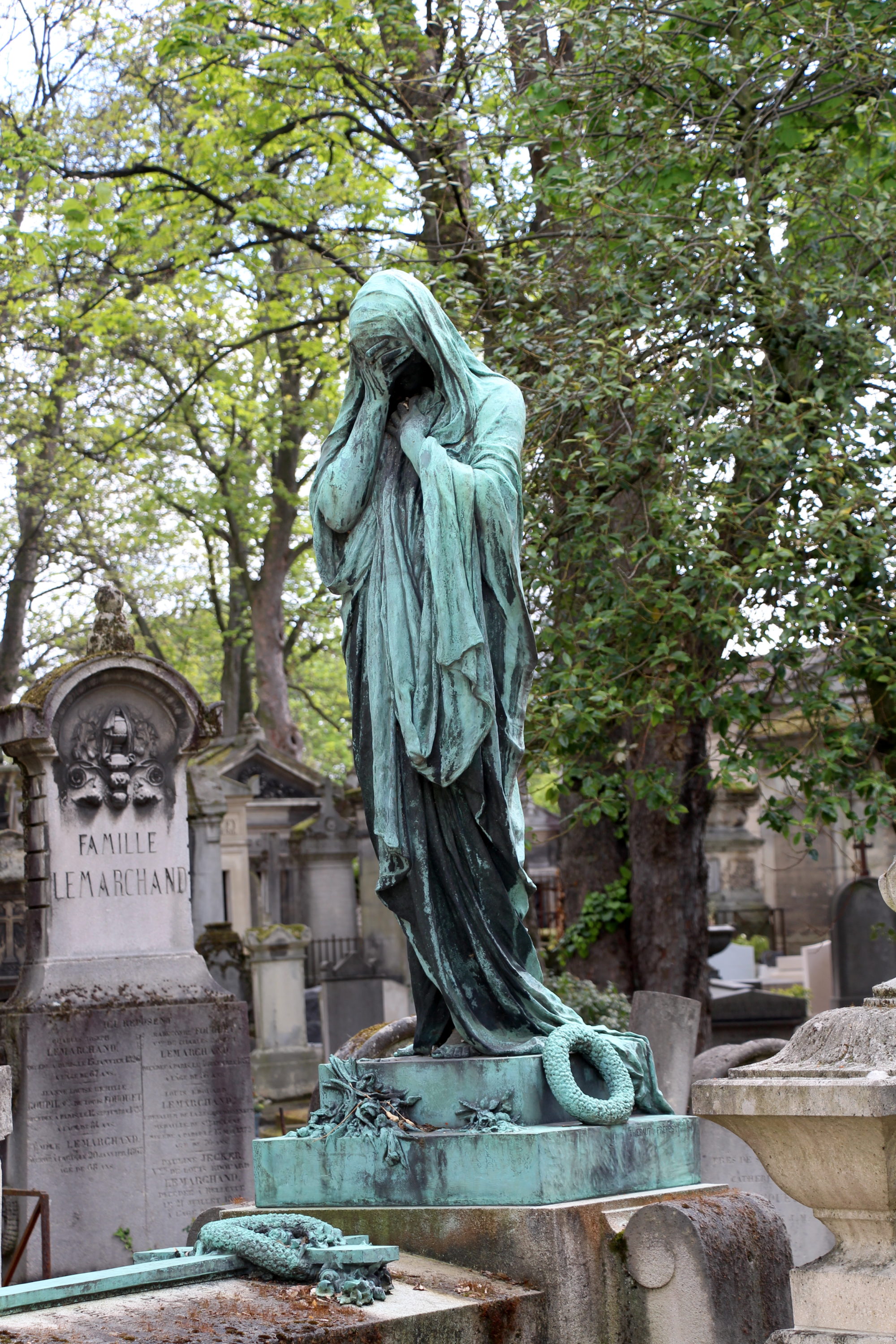1. For as gory as Paris’ history can be (thousands of people were guillotined on the public square from June 1793 to July 1794 alone), Parisians aren’t too into the idea of “hauntings,” which you’ll find much more frequently discussed across the Channel. That said, there are a few spooky spots you can visit if you’re looking for a Halloween vibe, starting with Père Lachaise Cemetery.
This famous burial ground is home not only to notable graves such as that of Oscar Wilde, Jim Morrison, and Marcel Proust, but also to quite a few beautifully eerie tombs, such as this one, which can be found at the Place Casimir Perier inside the cemetery.
2. The aforementioned public guillotinings generally took place on what is now known as Place de la Concorde, where you’ll find the obelisk that was stolen from Egypt by Napoleon I. But before the guillotine was invented, many public executions took place on what was then known as the Place de Grève – now named for the Hôtel de Ville (City Hall) that was built in 1892.
The most famous of these executions was that of François Ravaillac, the man who finally succeeded in killing King Henri IV after two failed attempts. Ravaillac, a Catholic zealot opposed to the fact that the Calvinist-raised Henri was sitting on the French throne, was tortured with burning sulphur and molten lead before being drawn and quartered on the Place de Grève. It’s said that the people of Paris, so angered at the loss of their affable king, swarmed the body and tore it to pieces, cannibalizing bits of it and stealing others as souvenirs. The largest piece of Ravaillac to be found and buried after his execution was his shirt.
For years, controversy spread over the whereabouts of King Henri’s head, said to be removed from his body by Revolutionaries following the decapitation of the monarch at the time, Louis XVI. A mummified head found in 2008 was presumed by many – but not by all – to be that of the long-defunct monarch.
3. Henri’s reign was actually overall an unusually bloody one, through no fault of his own. His mother-in-law, Catherine de Medici, was one of the most mysterious and conniving monarchs of France’s history. After marrying King Henri II (and showing right away what kind of queen she intended to be by being the first woman to wear high heels at her own wedding so that she could tower over the king) and refusing to live in the Louvre palace, built by her father-in-law François I, in favor of building the new Tuileries palace (subsequently destroyed by the Revolutionaries), rumors about the Italian queen began to grow. Her interest in astrology convinced some that she was a witch, especially after her husband was killed in a jousting tournament while flying the colors of his mistress, Diane de Poitiers.
With her husband dead, Catherine set about grooming her three sons for the throne. Each died in mysterious circumstances, running out the bloodline and leaving only Henri IV, a distant cousin of her sons and a direct male-line descendant of Louis IX, to take the throne. Catherine married daughter off to the incumbent king to ensure her continued power, but when the Protestant Henri and Margaret were married, it set the stage for one of the bloodiest moments in Paris’ history: the St. Bartholomew’s Day Massacre.
This targeted group of assassinations was instigated by Catherine and took place a few days after the wedding of Margaret and Henri, which many wealthy and prominent Protestants had gathered in Paris to attend. The signal for the beginning of the killings was the ringing of matins at the parish church of the kings of France: Saint-Germain l’Auxerrois. Modern estimates for the number of dead across France during the Massacre total up to 30,000 people.
4. If one place in Paris were to be haunted by restless dead, however, I’d put my money on the Conciergerie. This former prison was home to hundreds of prisoners during the French Revolution, including Queen Marie Antoinette. Before that, however, the building was a medieval prison, home to a mix of common criminals and political prisoners. Lowly poorer prisoners were confined to vermin-infested cells in the basement known as oubliettes or forgotten places, where they were often quite literally forgotten and left for dead, their rotten bodies only removed to make place for more prisoners in their shackles.
5. For a real “creepy” factor, however, there’s no place better in Paris to go than the Catacombs. This portion of the quarries beneath the city of Paris are filled with the remains of six million Parisians, disinterred from cemeteries around Paris like the massive Saints-Innocents cemetery, which was once located near Châtelet.
I wonder what the dead think of the way in which their bones have been “aesthetically” arranged and photographed by visitors?




